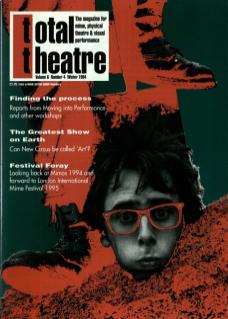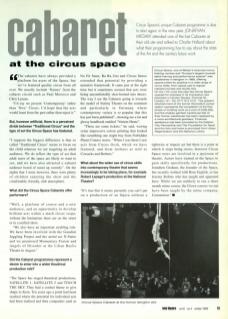‘The cabarets have always provided a platform for users of the Space, but we've featured quality circus from all over. We usually include Names from the cabaret circuit such as Paul Morocco and Chris Lynam.
I'd say we present Contemporary rather than “New” Circus. I'd hope that the acts would learn from the past rather than reject it.’
But, however artificial, there is a perceived divide between ‘Traditional Circus’ and the type of act the Circus Space has featured.
‘I suppose the biggest difference is that so called “Traditional Circus” seems to focus on the child whereas we are targeting an adult audience. We do reflect the type of act that adult users of the space are likely to want to see, and we have also attracted a cabaret audience bored of stand up comedy.’
On the nights that I went, however, there were plenty of children enjoying the show and the comfortable, friendly, club atmosphere. What did the Circus Space Cabarets offer performers?
‘Well, a platform of course and a new audience, and an opportunity to develop brilliant acts within a much closer scope, without the limitations there are on the street or in a unified show.
We also have an important enabling role. We have been involved with the Gandini Juggling Project and the aerial act X-Static, and we premiered Momentary Fusion and Angels of Disorder at the Lilian Baylis Theatre in August.’
Did the Cabaret programmes represent a desire to enter into a wider theatrical production role?
‘The Space has staged theatrical productions, Satellite 1, Satellite 2, and Touch the Sky. They had a central theme to give shape to them. Ten years ago a point had been reached where the potential for individual acts had been realised and then companies such as NoFit State, Ra-Ra Zoo, and Circus Senso extended that potential by providing a narrative framework. It came just at the right time but it sometimes seemed that acts were being uncomfortably shoe-horned into shows. The way I see the Cabarets going is towards the model of Variety Theatre on the continent, and particularly in Germany where contemporary variety is so popular that this has just been published [showing me a fat and glossy handbook entitled Variete-Heute].
‘These are some tickets,’ he said, waving some impressive colour printing that looked like something one might buy from Forbidden Planet Comics stores. ‘When I was there I saw acts from Circus Gosh, which we have featured, and from Archaos as well as Cossacks and Berbers.’
What about the wider use of circus skills in contemporary theatre that seems increasingly to be taking place, for example Robert Lepage's production at the National Theatre?
‘It's true that it seems presently you can't put on a production of an Opera without a tightwire or trapeze act but there is a point at which it stops being circus. However, Circus Space users are involved in a spectrum of theatre. Actors have trained at the Space to gain skills specifically for productions. Jonathan Graham, the founder of the Space, has recently worked with Rose English, as has Jeremy Robins who has taught and appeared here. While we are unlikely to run a three-month mime course, the Clown courses we run have been taught by the mime company, Commotion.
Circus Space, one of Britain's foremost circus training centres and Europe's largest ‘covered aerial training and performance spaces’ was established in Islington in 1989, offering opportunities for practice in a wide range of circus skills, from casual use to regular classes/courses and studio hire. On the 11 June this year the Circus Space opened for business in its impressive new premises in Hoxton Square, Coronet St. London, N1. The present refurbishment of the former Shoreditch power station represents the completion of the first phase of building work at a cost of £500,000, and the shabby-genteel warehouse feel of their former warehouse has been replaced by a more architectural grandeur. Financial assistance has been provided by the Dalston City Partnership and The Foundation for Sport and the Arts and more is promised from Urban Regeneration and the National Lottery.

